Leadership in Education: Curriculum Vision, Values, and Learning
VerifiedAdded on 2023/06/13
|11
|4225
|194
Report
AI Summary
This report delves into the critical aspects of leadership in education, focusing on its influence on curriculum vision, values, teaching, and learning. It examines the importance of effective school leadership in fostering a positive learning environment and achieving academic success, highlighting the role of vision and values in guiding educational practices. The report also identifies leadership barriers to implementing curriculum vision in India and explores transformational leadership as a model for driving positive change. Furthermore, it defines the 4Ls (Intellectual Stimulation, Individual Consideration, Inspirational Motivation, and Idealized Influence) and discusses their application in educational settings, emphasizing the significance of these elements in promoting student growth and development. This document is available on Desklib, a platform offering a wide range of educational resources and study tools for students.
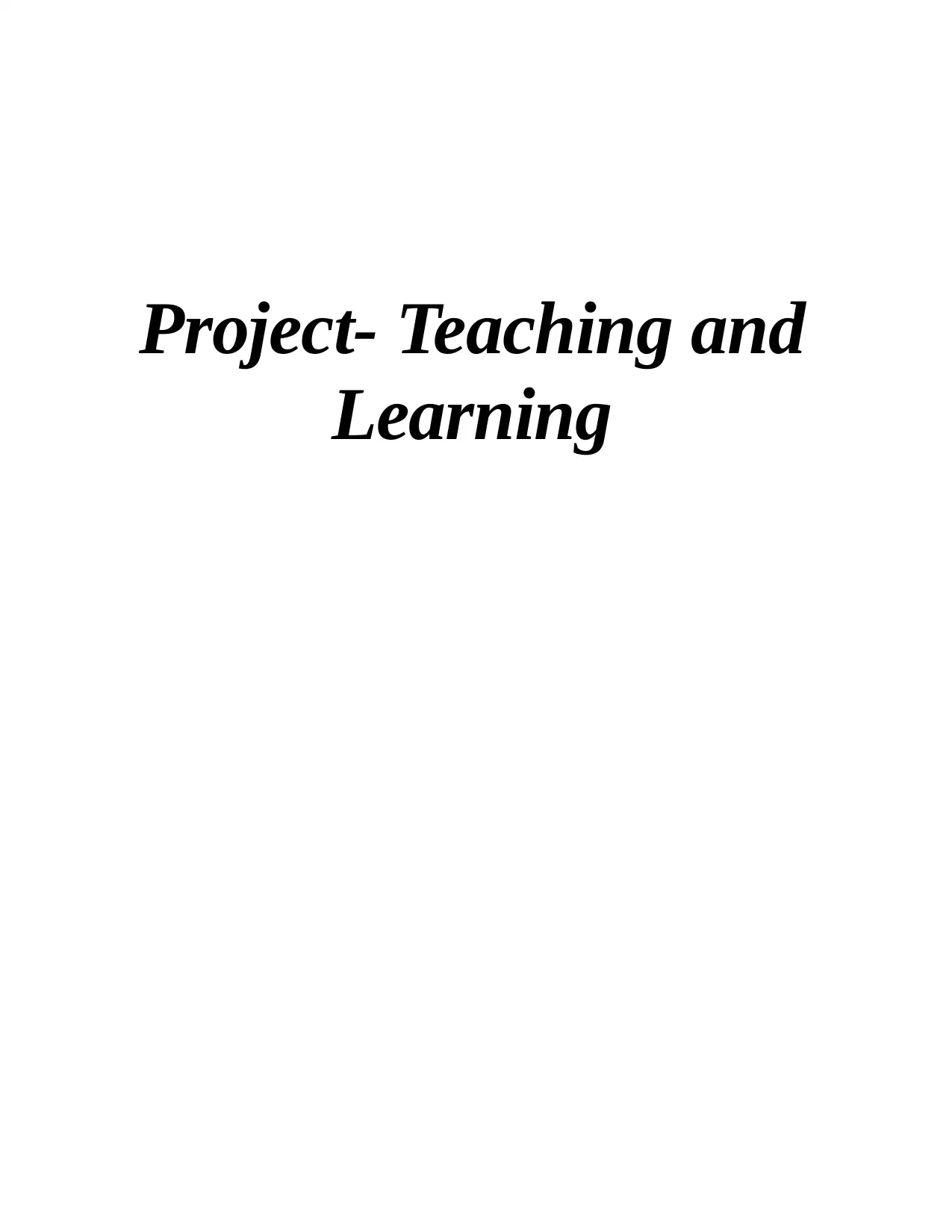
Project- Teaching and
Learning
Learning
Paraphrase This Document
Need a fresh take? Get an instant paraphrase of this document with our AI Paraphraser
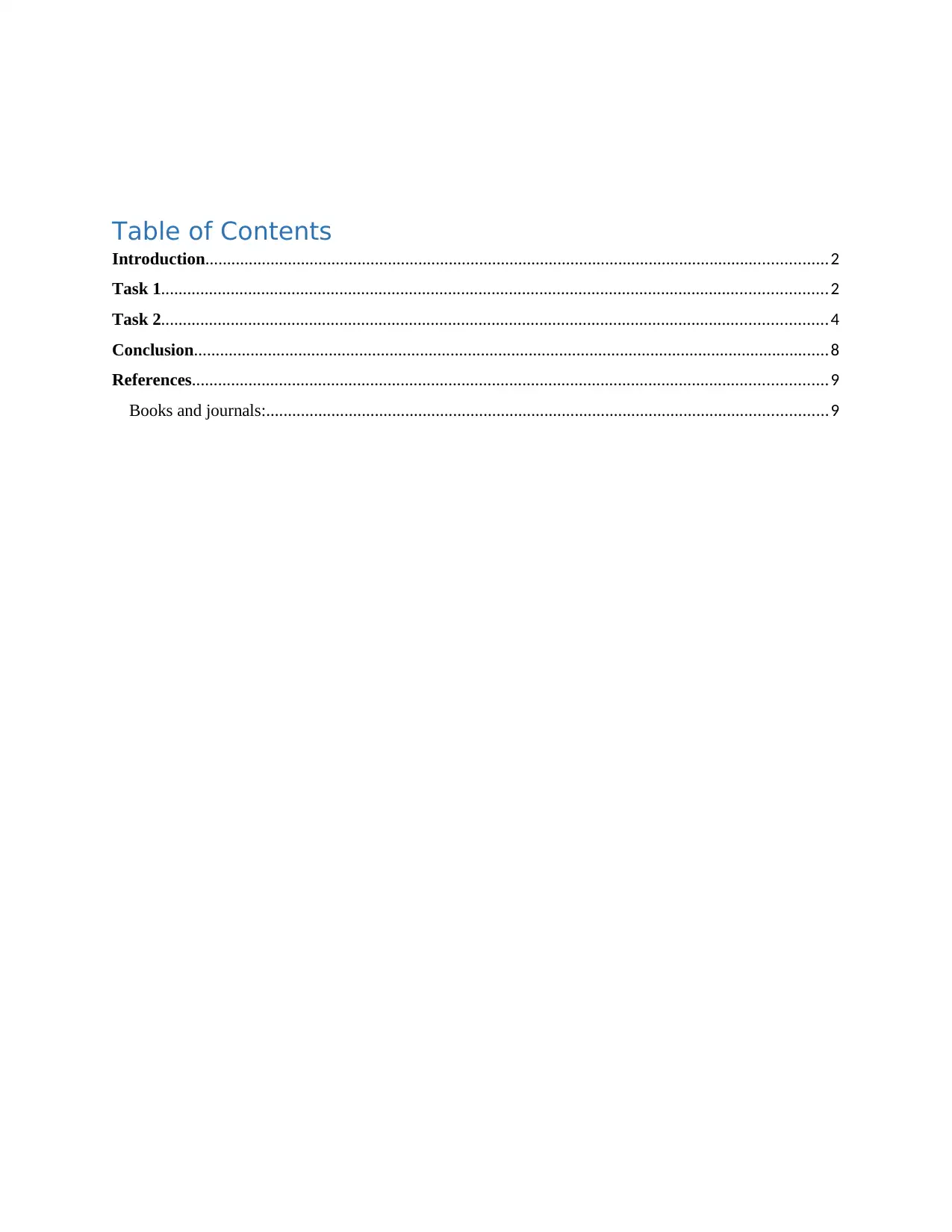
Table of Contents
Introduction...............................................................................................................................................2
Task 1.........................................................................................................................................................2
Task 2.........................................................................................................................................................4
Conclusion..................................................................................................................................................8
References..................................................................................................................................................9
Books and journals:.................................................................................................................................9
Introduction...............................................................................................................................................2
Task 1.........................................................................................................................................................2
Task 2.........................................................................................................................................................4
Conclusion..................................................................................................................................................8
References..................................................................................................................................................9
Books and journals:.................................................................................................................................9
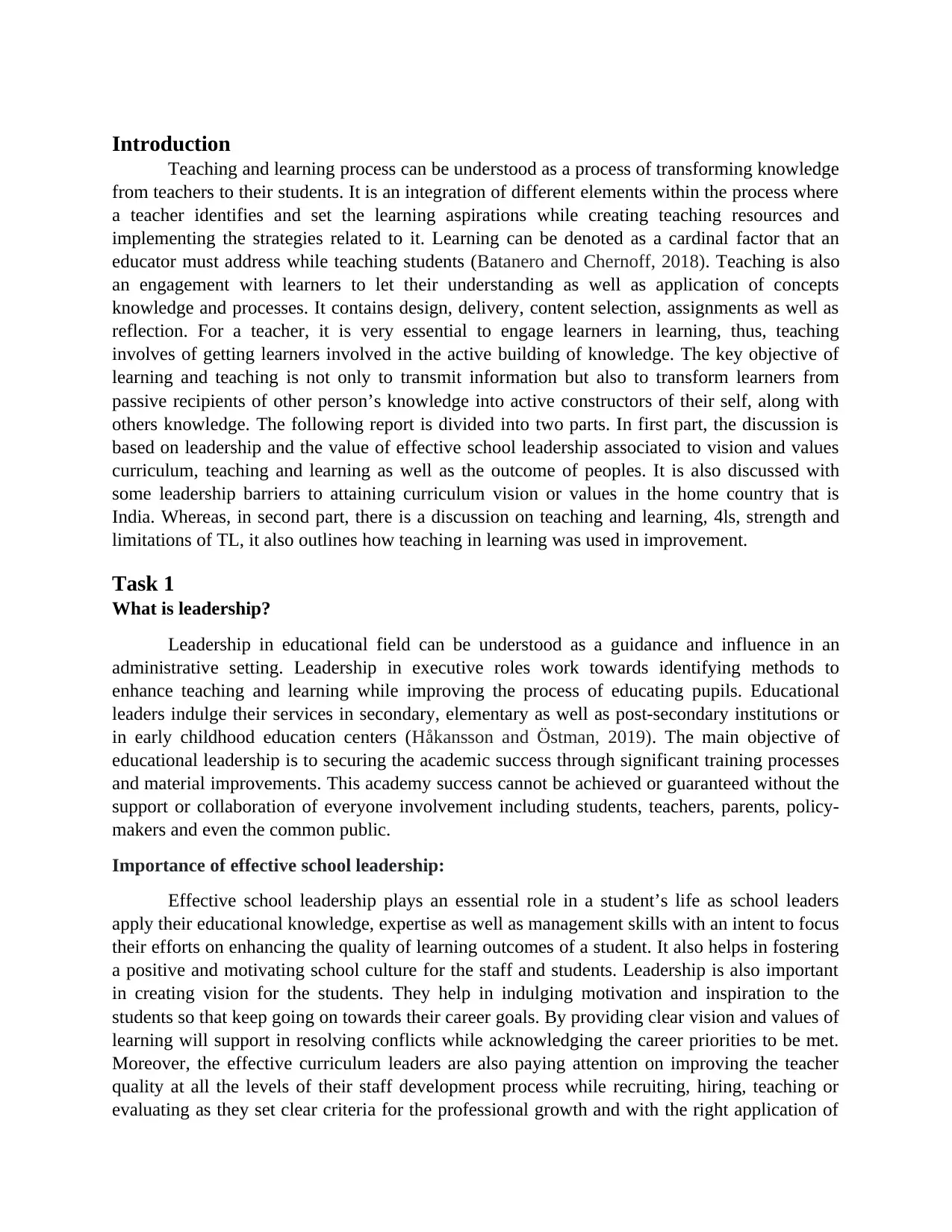
Introduction
Teaching and learning process can be understood as a process of transforming knowledge
from teachers to their students. It is an integration of different elements within the process where
a teacher identifies and set the learning aspirations while creating teaching resources and
implementing the strategies related to it. Learning can be denoted as a cardinal factor that an
educator must address while teaching students (Batanero and Chernoff, 2018). Teaching is also
an engagement with learners to let their understanding as well as application of concepts
knowledge and processes. It contains design, delivery, content selection, assignments as well as
reflection. For a teacher, it is very essential to engage learners in learning, thus, teaching
involves of getting learners involved in the active building of knowledge. The key objective of
learning and teaching is not only to transmit information but also to transform learners from
passive recipients of other person’s knowledge into active constructors of their self, along with
others knowledge. The following report is divided into two parts. In first part, the discussion is
based on leadership and the value of effective school leadership associated to vision and values
curriculum, teaching and learning as well as the outcome of peoples. It is also discussed with
some leadership barriers to attaining curriculum vision or values in the home country that is
India. Whereas, in second part, there is a discussion on teaching and learning, 4ls, strength and
limitations of TL, it also outlines how teaching in learning was used in improvement.
Task 1
What is leadership?
Leadership in educational field can be understood as a guidance and influence in an
administrative setting. Leadership in executive roles work towards identifying methods to
enhance teaching and learning while improving the process of educating pupils. Educational
leaders indulge their services in secondary, elementary as well as post-secondary institutions or
in early childhood education centers (Håkansson and Östman, 2019). The main objective of
educational leadership is to securing the academic success through significant training processes
and material improvements. This academy success cannot be achieved or guaranteed without the
support or collaboration of everyone involvement including students, teachers, parents, policy-
makers and even the common public.
Importance of effective school leadership:
Effective school leadership plays an essential role in a student’s life as school leaders
apply their educational knowledge, expertise as well as management skills with an intent to focus
their efforts on enhancing the quality of learning outcomes of a student. It also helps in fostering
a positive and motivating school culture for the staff and students. Leadership is also important
in creating vision for the students. They help in indulging motivation and inspiration to the
students so that keep going on towards their career goals. By providing clear vision and values of
learning will support in resolving conflicts while acknowledging the career priorities to be met.
Moreover, the effective curriculum leaders are also paying attention on improving the teacher
quality at all the levels of their staff development process while recruiting, hiring, teaching or
evaluating as they set clear criteria for the professional growth and with the right application of
Teaching and learning process can be understood as a process of transforming knowledge
from teachers to their students. It is an integration of different elements within the process where
a teacher identifies and set the learning aspirations while creating teaching resources and
implementing the strategies related to it. Learning can be denoted as a cardinal factor that an
educator must address while teaching students (Batanero and Chernoff, 2018). Teaching is also
an engagement with learners to let their understanding as well as application of concepts
knowledge and processes. It contains design, delivery, content selection, assignments as well as
reflection. For a teacher, it is very essential to engage learners in learning, thus, teaching
involves of getting learners involved in the active building of knowledge. The key objective of
learning and teaching is not only to transmit information but also to transform learners from
passive recipients of other person’s knowledge into active constructors of their self, along with
others knowledge. The following report is divided into two parts. In first part, the discussion is
based on leadership and the value of effective school leadership associated to vision and values
curriculum, teaching and learning as well as the outcome of peoples. It is also discussed with
some leadership barriers to attaining curriculum vision or values in the home country that is
India. Whereas, in second part, there is a discussion on teaching and learning, 4ls, strength and
limitations of TL, it also outlines how teaching in learning was used in improvement.
Task 1
What is leadership?
Leadership in educational field can be understood as a guidance and influence in an
administrative setting. Leadership in executive roles work towards identifying methods to
enhance teaching and learning while improving the process of educating pupils. Educational
leaders indulge their services in secondary, elementary as well as post-secondary institutions or
in early childhood education centers (Håkansson and Östman, 2019). The main objective of
educational leadership is to securing the academic success through significant training processes
and material improvements. This academy success cannot be achieved or guaranteed without the
support or collaboration of everyone involvement including students, teachers, parents, policy-
makers and even the common public.
Importance of effective school leadership:
Effective school leadership plays an essential role in a student’s life as school leaders
apply their educational knowledge, expertise as well as management skills with an intent to focus
their efforts on enhancing the quality of learning outcomes of a student. It also helps in fostering
a positive and motivating school culture for the staff and students. Leadership is also important
in creating vision for the students. They help in indulging motivation and inspiration to the
students so that keep going on towards their career goals. By providing clear vision and values of
learning will support in resolving conflicts while acknowledging the career priorities to be met.
Moreover, the effective curriculum leaders are also paying attention on improving the teacher
quality at all the levels of their staff development process while recruiting, hiring, teaching or
evaluating as they set clear criteria for the professional growth and with the right application of
⊘ This is a preview!⊘
Do you want full access?
Subscribe today to unlock all pages.

Trusted by 1+ million students worldwide
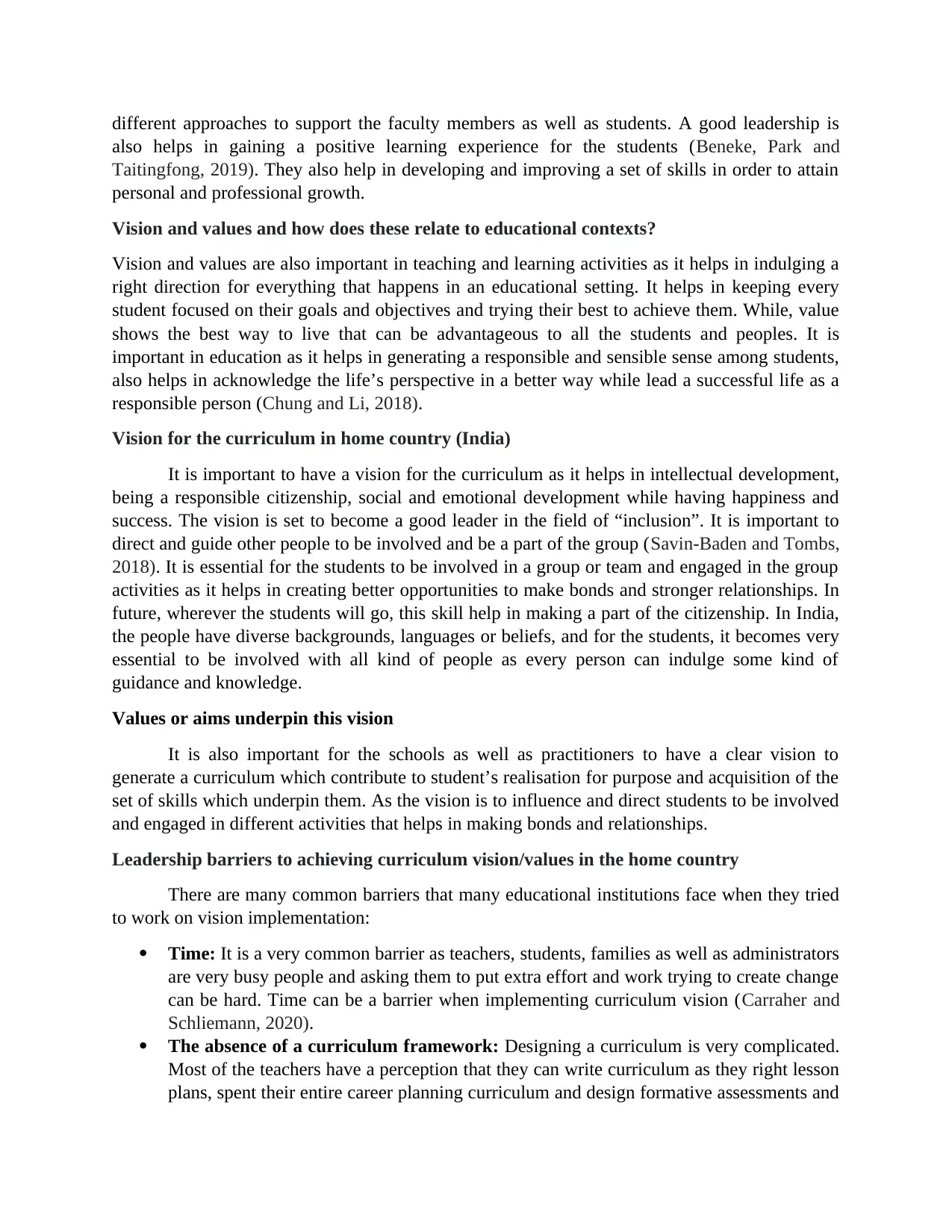
different approaches to support the faculty members as well as students. A good leadership is
also helps in gaining a positive learning experience for the students (Beneke, Park and
Taitingfong, 2019). They also help in developing and improving a set of skills in order to attain
personal and professional growth.
Vision and values and how does these relate to educational contexts?
Vision and values are also important in teaching and learning activities as it helps in indulging a
right direction for everything that happens in an educational setting. It helps in keeping every
student focused on their goals and objectives and trying their best to achieve them. While, value
shows the best way to live that can be advantageous to all the students and peoples. It is
important in education as it helps in generating a responsible and sensible sense among students,
also helps in acknowledge the life’s perspective in a better way while lead a successful life as a
responsible person (Chung and Li, 2018).
Vision for the curriculum in home country (India)
It is important to have a vision for the curriculum as it helps in intellectual development,
being a responsible citizenship, social and emotional development while having happiness and
success. The vision is set to become a good leader in the field of “inclusion”. It is important to
direct and guide other people to be involved and be a part of the group (Savin-Baden and Tombs,
2018). It is essential for the students to be involved in a group or team and engaged in the group
activities as it helps in creating better opportunities to make bonds and stronger relationships. In
future, wherever the students will go, this skill help in making a part of the citizenship. In India,
the people have diverse backgrounds, languages or beliefs, and for the students, it becomes very
essential to be involved with all kind of people as every person can indulge some kind of
guidance and knowledge.
Values or aims underpin this vision
It is also important for the schools as well as practitioners to have a clear vision to
generate a curriculum which contribute to student’s realisation for purpose and acquisition of the
set of skills which underpin them. As the vision is to influence and direct students to be involved
and engaged in different activities that helps in making bonds and relationships.
Leadership barriers to achieving curriculum vision/values in the home country
There are many common barriers that many educational institutions face when they tried
to work on vision implementation:
Time: It is a very common barrier as teachers, students, families as well as administrators
are very busy people and asking them to put extra effort and work trying to create change
can be hard. Time can be a barrier when implementing curriculum vision (Carraher and
Schliemann, 2020).
The absence of a curriculum framework: Designing a curriculum is very complicated.
Most of the teachers have a perception that they can write curriculum as they right lesson
plans, spent their entire career planning curriculum and design formative assessments and
also helps in gaining a positive learning experience for the students (Beneke, Park and
Taitingfong, 2019). They also help in developing and improving a set of skills in order to attain
personal and professional growth.
Vision and values and how does these relate to educational contexts?
Vision and values are also important in teaching and learning activities as it helps in indulging a
right direction for everything that happens in an educational setting. It helps in keeping every
student focused on their goals and objectives and trying their best to achieve them. While, value
shows the best way to live that can be advantageous to all the students and peoples. It is
important in education as it helps in generating a responsible and sensible sense among students,
also helps in acknowledge the life’s perspective in a better way while lead a successful life as a
responsible person (Chung and Li, 2018).
Vision for the curriculum in home country (India)
It is important to have a vision for the curriculum as it helps in intellectual development,
being a responsible citizenship, social and emotional development while having happiness and
success. The vision is set to become a good leader in the field of “inclusion”. It is important to
direct and guide other people to be involved and be a part of the group (Savin-Baden and Tombs,
2018). It is essential for the students to be involved in a group or team and engaged in the group
activities as it helps in creating better opportunities to make bonds and stronger relationships. In
future, wherever the students will go, this skill help in making a part of the citizenship. In India,
the people have diverse backgrounds, languages or beliefs, and for the students, it becomes very
essential to be involved with all kind of people as every person can indulge some kind of
guidance and knowledge.
Values or aims underpin this vision
It is also important for the schools as well as practitioners to have a clear vision to
generate a curriculum which contribute to student’s realisation for purpose and acquisition of the
set of skills which underpin them. As the vision is to influence and direct students to be involved
and engaged in different activities that helps in making bonds and relationships.
Leadership barriers to achieving curriculum vision/values in the home country
There are many common barriers that many educational institutions face when they tried
to work on vision implementation:
Time: It is a very common barrier as teachers, students, families as well as administrators
are very busy people and asking them to put extra effort and work trying to create change
can be hard. Time can be a barrier when implementing curriculum vision (Carraher and
Schliemann, 2020).
The absence of a curriculum framework: Designing a curriculum is very complicated.
Most of the teachers have a perception that they can write curriculum as they right lesson
plans, spent their entire career planning curriculum and design formative assessments and
Paraphrase This Document
Need a fresh take? Get an instant paraphrase of this document with our AI Paraphraser
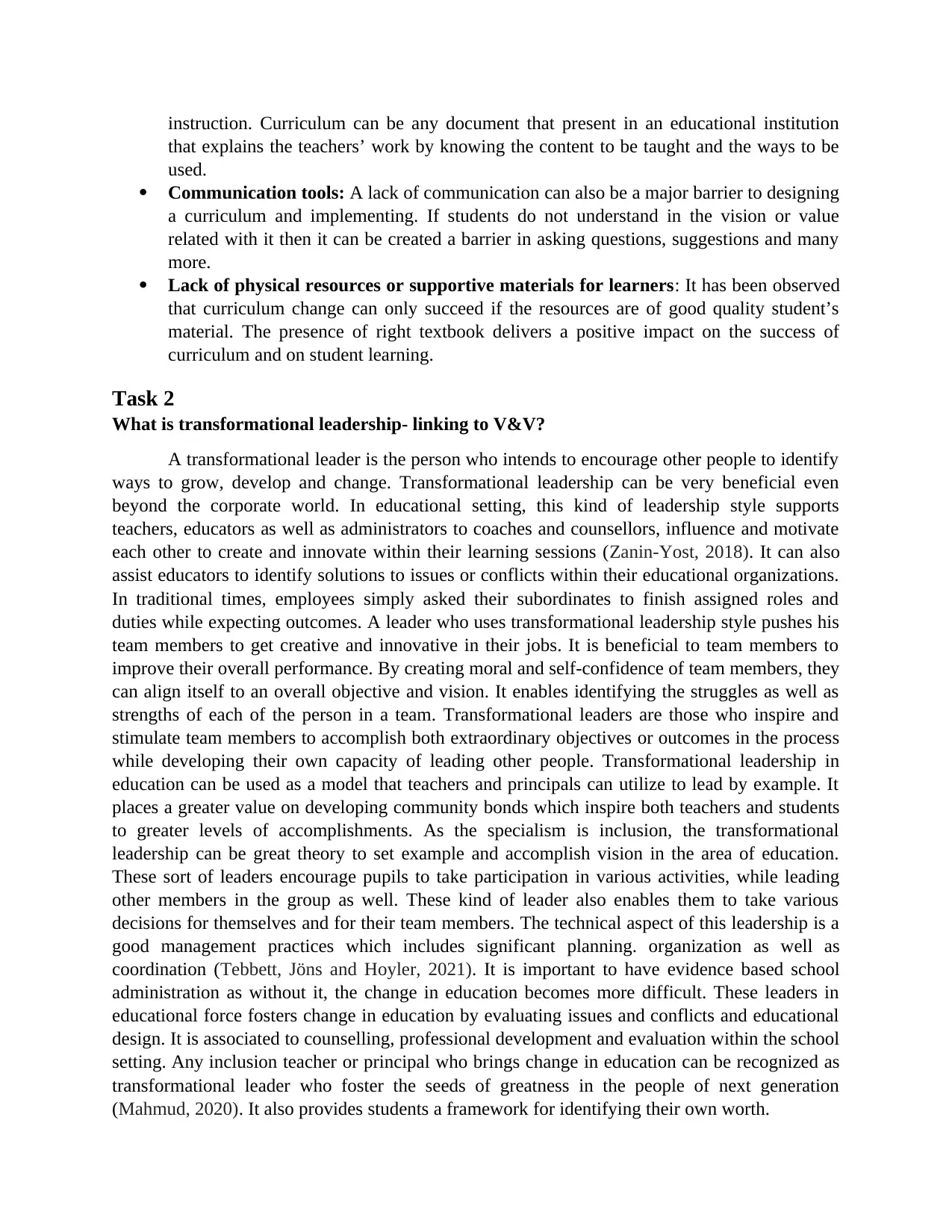
instruction. Curriculum can be any document that present in an educational institution
that explains the teachers’ work by knowing the content to be taught and the ways to be
used.
Communication tools: A lack of communication can also be a major barrier to designing
a curriculum and implementing. If students do not understand in the vision or value
related with it then it can be created a barrier in asking questions, suggestions and many
more.
Lack of physical resources or supportive materials for learners: It has been observed
that curriculum change can only succeed if the resources are of good quality student’s
material. The presence of right textbook delivers a positive impact on the success of
curriculum and on student learning.
Task 2
What is transformational leadership- linking to V&V?
A transformational leader is the person who intends to encourage other people to identify
ways to grow, develop and change. Transformational leadership can be very beneficial even
beyond the corporate world. In educational setting, this kind of leadership style supports
teachers, educators as well as administrators to coaches and counsellors, influence and motivate
each other to create and innovate within their learning sessions (Zanin-Yost, 2018). It can also
assist educators to identify solutions to issues or conflicts within their educational organizations.
In traditional times, employees simply asked their subordinates to finish assigned roles and
duties while expecting outcomes. A leader who uses transformational leadership style pushes his
team members to get creative and innovative in their jobs. It is beneficial to team members to
improve their overall performance. By creating moral and self-confidence of team members, they
can align itself to an overall objective and vision. It enables identifying the struggles as well as
strengths of each of the person in a team. Transformational leaders are those who inspire and
stimulate team members to accomplish both extraordinary objectives or outcomes in the process
while developing their own capacity of leading other people. Transformational leadership in
education can be used as a model that teachers and principals can utilize to lead by example. It
places a greater value on developing community bonds which inspire both teachers and students
to greater levels of accomplishments. As the specialism is inclusion, the transformational
leadership can be great theory to set example and accomplish vision in the area of education.
These sort of leaders encourage pupils to take participation in various activities, while leading
other members in the group as well. These kind of leader also enables them to take various
decisions for themselves and for their team members. The technical aspect of this leadership is a
good management practices which includes significant planning. organization as well as
coordination (Tebbett, Jöns and Hoyler, 2021). It is important to have evidence based school
administration as without it, the change in education becomes more difficult. These leaders in
educational force fosters change in education by evaluating issues and conflicts and educational
design. It is associated to counselling, professional development and evaluation within the school
setting. Any inclusion teacher or principal who brings change in education can be recognized as
transformational leader who foster the seeds of greatness in the people of next generation
(Mahmud, 2020). It also provides students a framework for identifying their own worth.
that explains the teachers’ work by knowing the content to be taught and the ways to be
used.
Communication tools: A lack of communication can also be a major barrier to designing
a curriculum and implementing. If students do not understand in the vision or value
related with it then it can be created a barrier in asking questions, suggestions and many
more.
Lack of physical resources or supportive materials for learners: It has been observed
that curriculum change can only succeed if the resources are of good quality student’s
material. The presence of right textbook delivers a positive impact on the success of
curriculum and on student learning.
Task 2
What is transformational leadership- linking to V&V?
A transformational leader is the person who intends to encourage other people to identify
ways to grow, develop and change. Transformational leadership can be very beneficial even
beyond the corporate world. In educational setting, this kind of leadership style supports
teachers, educators as well as administrators to coaches and counsellors, influence and motivate
each other to create and innovate within their learning sessions (Zanin-Yost, 2018). It can also
assist educators to identify solutions to issues or conflicts within their educational organizations.
In traditional times, employees simply asked their subordinates to finish assigned roles and
duties while expecting outcomes. A leader who uses transformational leadership style pushes his
team members to get creative and innovative in their jobs. It is beneficial to team members to
improve their overall performance. By creating moral and self-confidence of team members, they
can align itself to an overall objective and vision. It enables identifying the struggles as well as
strengths of each of the person in a team. Transformational leaders are those who inspire and
stimulate team members to accomplish both extraordinary objectives or outcomes in the process
while developing their own capacity of leading other people. Transformational leadership in
education can be used as a model that teachers and principals can utilize to lead by example. It
places a greater value on developing community bonds which inspire both teachers and students
to greater levels of accomplishments. As the specialism is inclusion, the transformational
leadership can be great theory to set example and accomplish vision in the area of education.
These sort of leaders encourage pupils to take participation in various activities, while leading
other members in the group as well. These kind of leader also enables them to take various
decisions for themselves and for their team members. The technical aspect of this leadership is a
good management practices which includes significant planning. organization as well as
coordination (Tebbett, Jöns and Hoyler, 2021). It is important to have evidence based school
administration as without it, the change in education becomes more difficult. These leaders in
educational force fosters change in education by evaluating issues and conflicts and educational
design. It is associated to counselling, professional development and evaluation within the school
setting. Any inclusion teacher or principal who brings change in education can be recognized as
transformational leader who foster the seeds of greatness in the people of next generation
(Mahmud, 2020). It also provides students a framework for identifying their own worth.
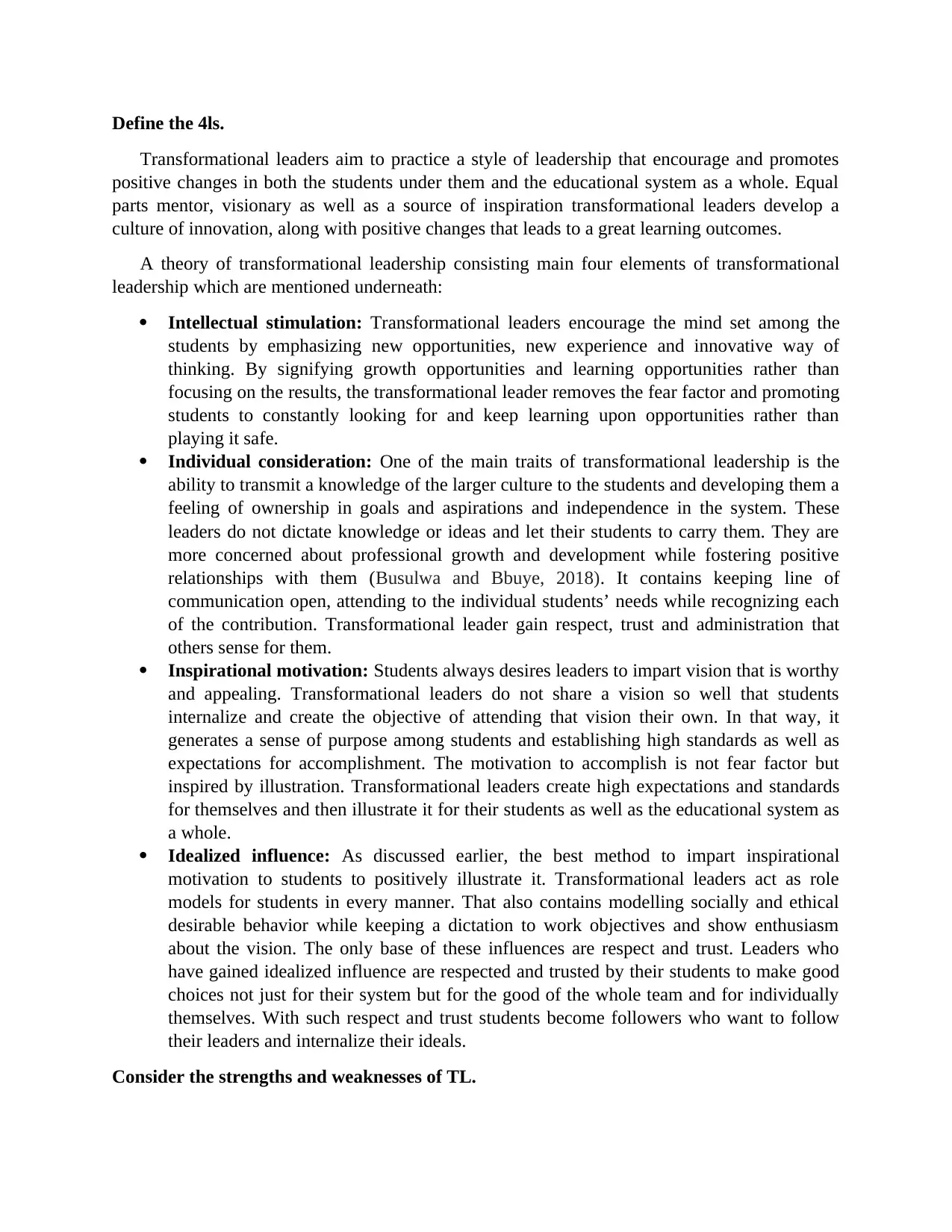
Define the 4ls.
Transformational leaders aim to practice a style of leadership that encourage and promotes
positive changes in both the students under them and the educational system as a whole. Equal
parts mentor, visionary as well as a source of inspiration transformational leaders develop a
culture of innovation, along with positive changes that leads to a great learning outcomes.
A theory of transformational leadership consisting main four elements of transformational
leadership which are mentioned underneath:
Intellectual stimulation: Transformational leaders encourage the mind set among the
students by emphasizing new opportunities, new experience and innovative way of
thinking. By signifying growth opportunities and learning opportunities rather than
focusing on the results, the transformational leader removes the fear factor and promoting
students to constantly looking for and keep learning upon opportunities rather than
playing it safe.
Individual consideration: One of the main traits of transformational leadership is the
ability to transmit a knowledge of the larger culture to the students and developing them a
feeling of ownership in goals and aspirations and independence in the system. These
leaders do not dictate knowledge or ideas and let their students to carry them. They are
more concerned about professional growth and development while fostering positive
relationships with them (Busulwa and Bbuye, 2018). It contains keeping line of
communication open, attending to the individual students’ needs while recognizing each
of the contribution. Transformational leader gain respect, trust and administration that
others sense for them.
Inspirational motivation: Students always desires leaders to impart vision that is worthy
and appealing. Transformational leaders do not share a vision so well that students
internalize and create the objective of attending that vision their own. In that way, it
generates a sense of purpose among students and establishing high standards as well as
expectations for accomplishment. The motivation to accomplish is not fear factor but
inspired by illustration. Transformational leaders create high expectations and standards
for themselves and then illustrate it for their students as well as the educational system as
a whole.
Idealized influence: As discussed earlier, the best method to impart inspirational
motivation to students to positively illustrate it. Transformational leaders act as role
models for students in every manner. That also contains modelling socially and ethical
desirable behavior while keeping a dictation to work objectives and show enthusiasm
about the vision. The only base of these influences are respect and trust. Leaders who
have gained idealized influence are respected and trusted by their students to make good
choices not just for their system but for the good of the whole team and for individually
themselves. With such respect and trust students become followers who want to follow
their leaders and internalize their ideals.
Consider the strengths and weaknesses of TL.
Transformational leaders aim to practice a style of leadership that encourage and promotes
positive changes in both the students under them and the educational system as a whole. Equal
parts mentor, visionary as well as a source of inspiration transformational leaders develop a
culture of innovation, along with positive changes that leads to a great learning outcomes.
A theory of transformational leadership consisting main four elements of transformational
leadership which are mentioned underneath:
Intellectual stimulation: Transformational leaders encourage the mind set among the
students by emphasizing new opportunities, new experience and innovative way of
thinking. By signifying growth opportunities and learning opportunities rather than
focusing on the results, the transformational leader removes the fear factor and promoting
students to constantly looking for and keep learning upon opportunities rather than
playing it safe.
Individual consideration: One of the main traits of transformational leadership is the
ability to transmit a knowledge of the larger culture to the students and developing them a
feeling of ownership in goals and aspirations and independence in the system. These
leaders do not dictate knowledge or ideas and let their students to carry them. They are
more concerned about professional growth and development while fostering positive
relationships with them (Busulwa and Bbuye, 2018). It contains keeping line of
communication open, attending to the individual students’ needs while recognizing each
of the contribution. Transformational leader gain respect, trust and administration that
others sense for them.
Inspirational motivation: Students always desires leaders to impart vision that is worthy
and appealing. Transformational leaders do not share a vision so well that students
internalize and create the objective of attending that vision their own. In that way, it
generates a sense of purpose among students and establishing high standards as well as
expectations for accomplishment. The motivation to accomplish is not fear factor but
inspired by illustration. Transformational leaders create high expectations and standards
for themselves and then illustrate it for their students as well as the educational system as
a whole.
Idealized influence: As discussed earlier, the best method to impart inspirational
motivation to students to positively illustrate it. Transformational leaders act as role
models for students in every manner. That also contains modelling socially and ethical
desirable behavior while keeping a dictation to work objectives and show enthusiasm
about the vision. The only base of these influences are respect and trust. Leaders who
have gained idealized influence are respected and trusted by their students to make good
choices not just for their system but for the good of the whole team and for individually
themselves. With such respect and trust students become followers who want to follow
their leaders and internalize their ideals.
Consider the strengths and weaknesses of TL.
⊘ This is a preview!⊘
Do you want full access?
Subscribe today to unlock all pages.

Trusted by 1+ million students worldwide
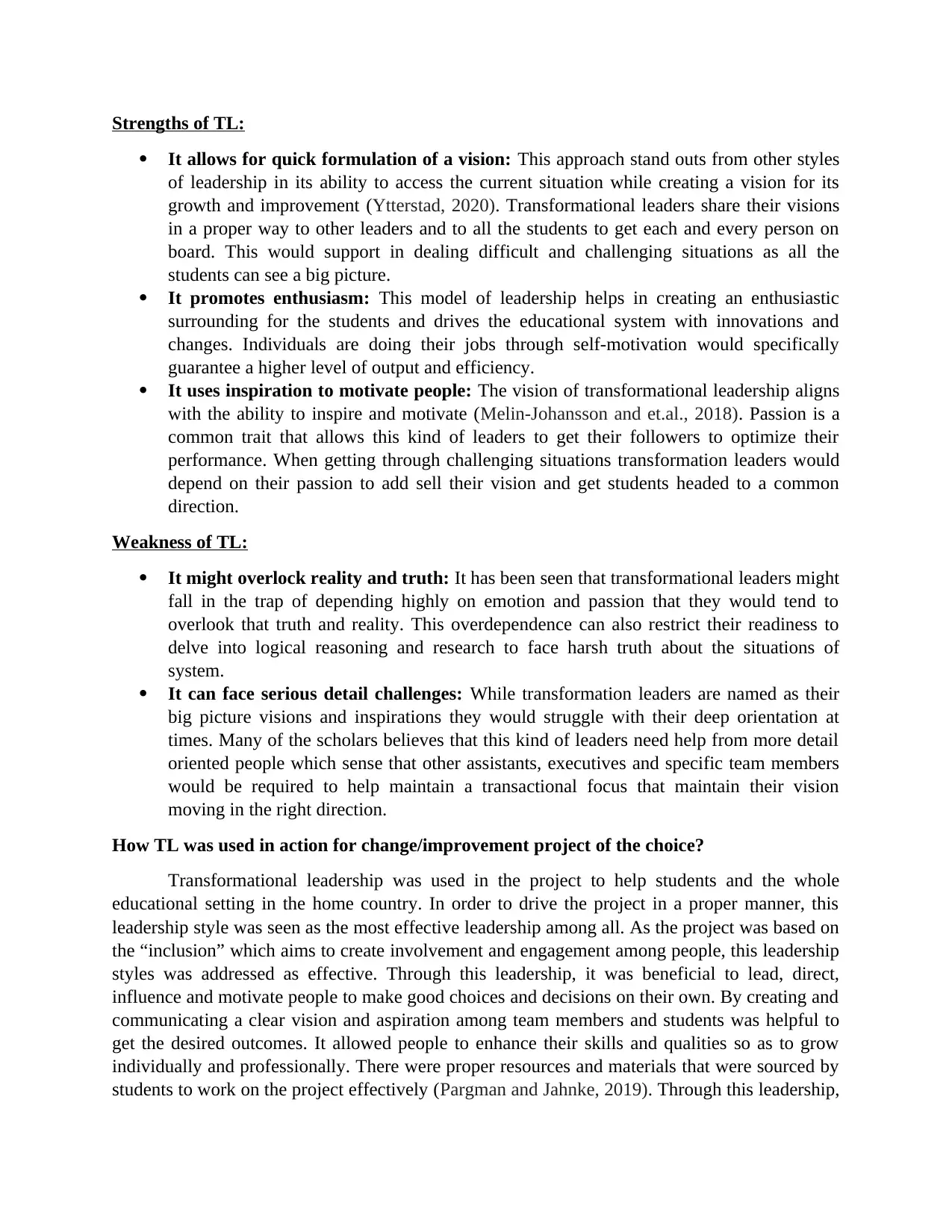
Strengths of TL:
It allows for quick formulation of a vision: This approach stand outs from other styles
of leadership in its ability to access the current situation while creating a vision for its
growth and improvement (Ytterstad, 2020). Transformational leaders share their visions
in a proper way to other leaders and to all the students to get each and every person on
board. This would support in dealing difficult and challenging situations as all the
students can see a big picture.
It promotes enthusiasm: This model of leadership helps in creating an enthusiastic
surrounding for the students and drives the educational system with innovations and
changes. Individuals are doing their jobs through self-motivation would specifically
guarantee a higher level of output and efficiency.
It uses inspiration to motivate people: The vision of transformational leadership aligns
with the ability to inspire and motivate (Melin-Johansson and et.al., 2018). Passion is a
common trait that allows this kind of leaders to get their followers to optimize their
performance. When getting through challenging situations transformation leaders would
depend on their passion to add sell their vision and get students headed to a common
direction.
Weakness of TL:
It might overlock reality and truth: It has been seen that transformational leaders might
fall in the trap of depending highly on emotion and passion that they would tend to
overlook that truth and reality. This overdependence can also restrict their readiness to
delve into logical reasoning and research to face harsh truth about the situations of
system.
It can face serious detail challenges: While transformation leaders are named as their
big picture visions and inspirations they would struggle with their deep orientation at
times. Many of the scholars believes that this kind of leaders need help from more detail
oriented people which sense that other assistants, executives and specific team members
would be required to help maintain a transactional focus that maintain their vision
moving in the right direction.
How TL was used in action for change/improvement project of the choice?
Transformational leadership was used in the project to help students and the whole
educational setting in the home country. In order to drive the project in a proper manner, this
leadership style was seen as the most effective leadership among all. As the project was based on
the “inclusion” which aims to create involvement and engagement among people, this leadership
styles was addressed as effective. Through this leadership, it was beneficial to lead, direct,
influence and motivate people to make good choices and decisions on their own. By creating and
communicating a clear vision and aspiration among team members and students was helpful to
get the desired outcomes. It allowed people to enhance their skills and qualities so as to grow
individually and professionally. There were proper resources and materials that were sourced by
students to work on the project effectively (Pargman and Jahnke, 2019). Through this leadership,
It allows for quick formulation of a vision: This approach stand outs from other styles
of leadership in its ability to access the current situation while creating a vision for its
growth and improvement (Ytterstad, 2020). Transformational leaders share their visions
in a proper way to other leaders and to all the students to get each and every person on
board. This would support in dealing difficult and challenging situations as all the
students can see a big picture.
It promotes enthusiasm: This model of leadership helps in creating an enthusiastic
surrounding for the students and drives the educational system with innovations and
changes. Individuals are doing their jobs through self-motivation would specifically
guarantee a higher level of output and efficiency.
It uses inspiration to motivate people: The vision of transformational leadership aligns
with the ability to inspire and motivate (Melin-Johansson and et.al., 2018). Passion is a
common trait that allows this kind of leaders to get their followers to optimize their
performance. When getting through challenging situations transformation leaders would
depend on their passion to add sell their vision and get students headed to a common
direction.
Weakness of TL:
It might overlock reality and truth: It has been seen that transformational leaders might
fall in the trap of depending highly on emotion and passion that they would tend to
overlook that truth and reality. This overdependence can also restrict their readiness to
delve into logical reasoning and research to face harsh truth about the situations of
system.
It can face serious detail challenges: While transformation leaders are named as their
big picture visions and inspirations they would struggle with their deep orientation at
times. Many of the scholars believes that this kind of leaders need help from more detail
oriented people which sense that other assistants, executives and specific team members
would be required to help maintain a transactional focus that maintain their vision
moving in the right direction.
How TL was used in action for change/improvement project of the choice?
Transformational leadership was used in the project to help students and the whole
educational setting in the home country. In order to drive the project in a proper manner, this
leadership style was seen as the most effective leadership among all. As the project was based on
the “inclusion” which aims to create involvement and engagement among people, this leadership
styles was addressed as effective. Through this leadership, it was beneficial to lead, direct,
influence and motivate people to make good choices and decisions on their own. By creating and
communicating a clear vision and aspiration among team members and students was helpful to
get the desired outcomes. It allowed people to enhance their skills and qualities so as to grow
individually and professionally. There were proper resources and materials that were sourced by
students to work on the project effectively (Pargman and Jahnke, 2019). Through this leadership,
Paraphrase This Document
Need a fresh take? Get an instant paraphrase of this document with our AI Paraphraser
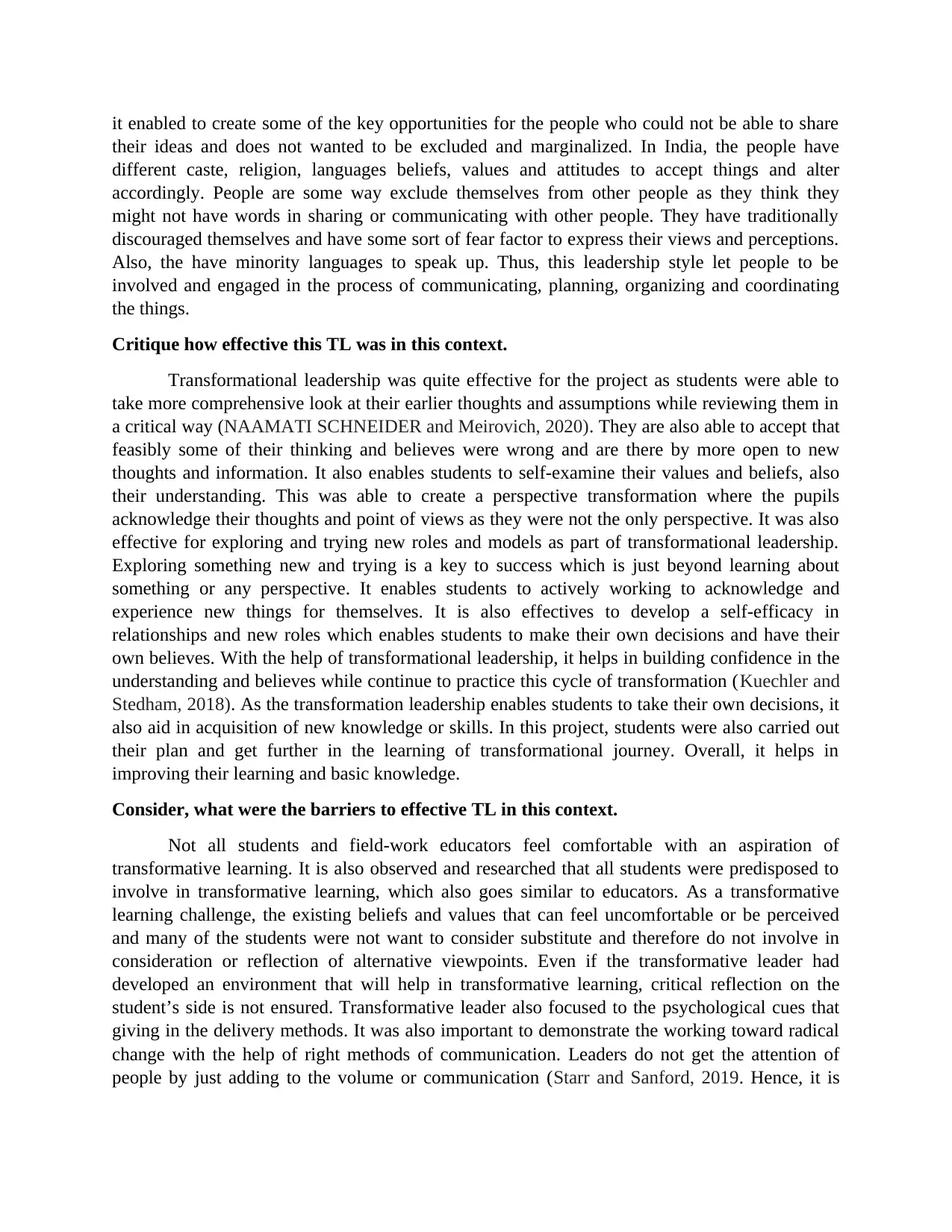
it enabled to create some of the key opportunities for the people who could not be able to share
their ideas and does not wanted to be excluded and marginalized. In India, the people have
different caste, religion, languages beliefs, values and attitudes to accept things and alter
accordingly. People are some way exclude themselves from other people as they think they
might not have words in sharing or communicating with other people. They have traditionally
discouraged themselves and have some sort of fear factor to express their views and perceptions.
Also, the have minority languages to speak up. Thus, this leadership style let people to be
involved and engaged in the process of communicating, planning, organizing and coordinating
the things.
Critique how effective this TL was in this context.
Transformational leadership was quite effective for the project as students were able to
take more comprehensive look at their earlier thoughts and assumptions while reviewing them in
a critical way (NAAMATI SCHNEIDER and Meirovich, 2020). They are also able to accept that
feasibly some of their thinking and believes were wrong and are there by more open to new
thoughts and information. It also enables students to self-examine their values and beliefs, also
their understanding. This was able to create a perspective transformation where the pupils
acknowledge their thoughts and point of views as they were not the only perspective. It was also
effective for exploring and trying new roles and models as part of transformational leadership.
Exploring something new and trying is a key to success which is just beyond learning about
something or any perspective. It enables students to actively working to acknowledge and
experience new things for themselves. It is also effectives to develop a self-efficacy in
relationships and new roles which enables students to make their own decisions and have their
own believes. With the help of transformational leadership, it helps in building confidence in the
understanding and believes while continue to practice this cycle of transformation (Kuechler and
Stedham, 2018). As the transformation leadership enables students to take their own decisions, it
also aid in acquisition of new knowledge or skills. In this project, students were also carried out
their plan and get further in the learning of transformational journey. Overall, it helps in
improving their learning and basic knowledge.
Consider, what were the barriers to effective TL in this context.
Not all students and field-work educators feel comfortable with an aspiration of
transformative learning. It is also observed and researched that all students were predisposed to
involve in transformative learning, which also goes similar to educators. As a transformative
learning challenge, the existing beliefs and values that can feel uncomfortable or be perceived
and many of the students were not want to consider substitute and therefore do not involve in
consideration or reflection of alternative viewpoints. Even if the transformative leader had
developed an environment that will help in transformative learning, critical reflection on the
student’s side is not ensured. Transformative leader also focused to the psychological cues that
giving in the delivery methods. It was also important to demonstrate the working toward radical
change with the help of right methods of communication. Leaders do not get the attention of
people by just adding to the volume or communication (Starr and Sanford, 2019. Hence, it is
their ideas and does not wanted to be excluded and marginalized. In India, the people have
different caste, religion, languages beliefs, values and attitudes to accept things and alter
accordingly. People are some way exclude themselves from other people as they think they
might not have words in sharing or communicating with other people. They have traditionally
discouraged themselves and have some sort of fear factor to express their views and perceptions.
Also, the have minority languages to speak up. Thus, this leadership style let people to be
involved and engaged in the process of communicating, planning, organizing and coordinating
the things.
Critique how effective this TL was in this context.
Transformational leadership was quite effective for the project as students were able to
take more comprehensive look at their earlier thoughts and assumptions while reviewing them in
a critical way (NAAMATI SCHNEIDER and Meirovich, 2020). They are also able to accept that
feasibly some of their thinking and believes were wrong and are there by more open to new
thoughts and information. It also enables students to self-examine their values and beliefs, also
their understanding. This was able to create a perspective transformation where the pupils
acknowledge their thoughts and point of views as they were not the only perspective. It was also
effective for exploring and trying new roles and models as part of transformational leadership.
Exploring something new and trying is a key to success which is just beyond learning about
something or any perspective. It enables students to actively working to acknowledge and
experience new things for themselves. It is also effectives to develop a self-efficacy in
relationships and new roles which enables students to make their own decisions and have their
own believes. With the help of transformational leadership, it helps in building confidence in the
understanding and believes while continue to practice this cycle of transformation (Kuechler and
Stedham, 2018). As the transformation leadership enables students to take their own decisions, it
also aid in acquisition of new knowledge or skills. In this project, students were also carried out
their plan and get further in the learning of transformational journey. Overall, it helps in
improving their learning and basic knowledge.
Consider, what were the barriers to effective TL in this context.
Not all students and field-work educators feel comfortable with an aspiration of
transformative learning. It is also observed and researched that all students were predisposed to
involve in transformative learning, which also goes similar to educators. As a transformative
learning challenge, the existing beliefs and values that can feel uncomfortable or be perceived
and many of the students were not want to consider substitute and therefore do not involve in
consideration or reflection of alternative viewpoints. Even if the transformative leader had
developed an environment that will help in transformative learning, critical reflection on the
student’s side is not ensured. Transformative leader also focused to the psychological cues that
giving in the delivery methods. It was also important to demonstrate the working toward radical
change with the help of right methods of communication. Leaders do not get the attention of
people by just adding to the volume or communication (Starr and Sanford, 2019. Hence, it is
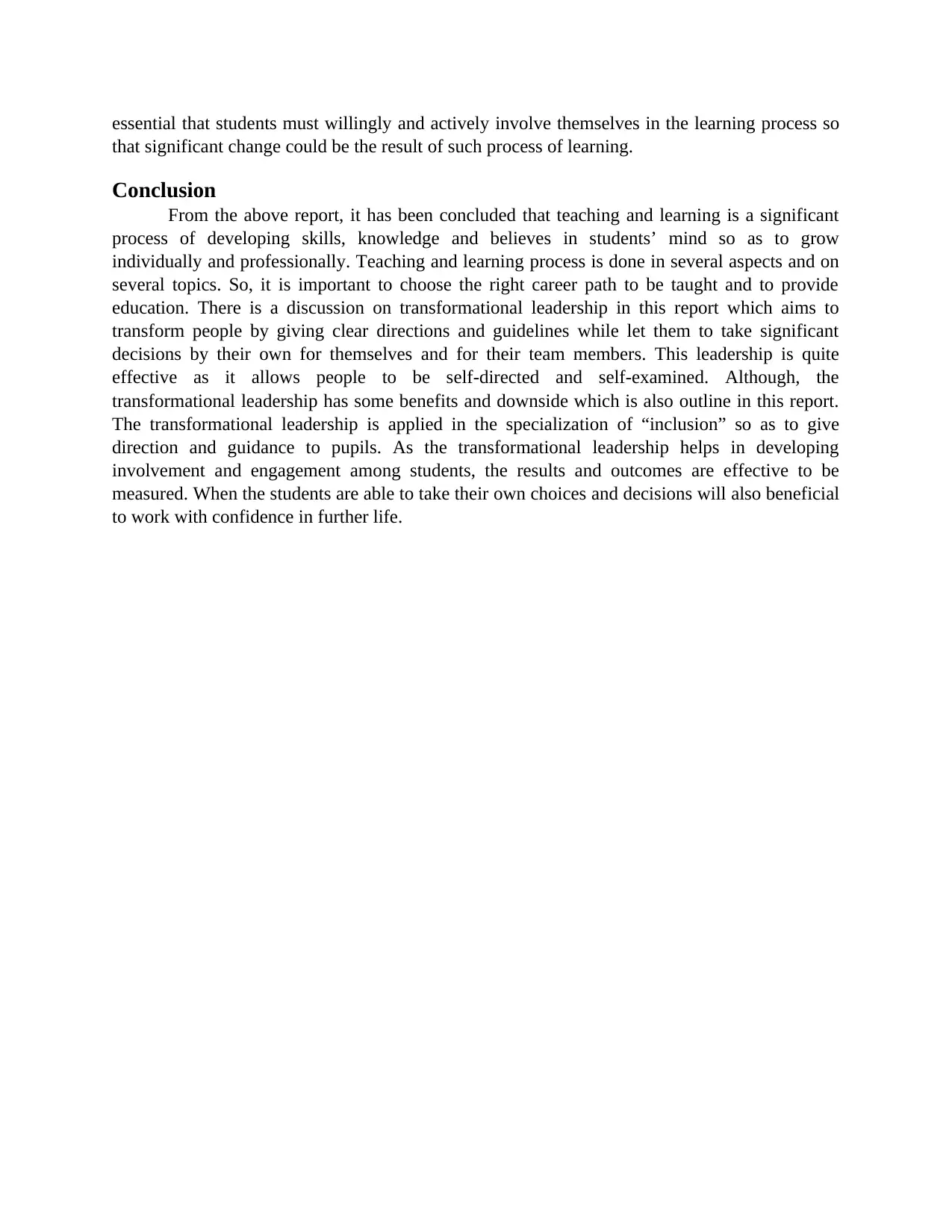
essential that students must willingly and actively involve themselves in the learning process so
that significant change could be the result of such process of learning.
Conclusion
From the above report, it has been concluded that teaching and learning is a significant
process of developing skills, knowledge and believes in students’ mind so as to grow
individually and professionally. Teaching and learning process is done in several aspects and on
several topics. So, it is important to choose the right career path to be taught and to provide
education. There is a discussion on transformational leadership in this report which aims to
transform people by giving clear directions and guidelines while let them to take significant
decisions by their own for themselves and for their team members. This leadership is quite
effective as it allows people to be self-directed and self-examined. Although, the
transformational leadership has some benefits and downside which is also outline in this report.
The transformational leadership is applied in the specialization of “inclusion” so as to give
direction and guidance to pupils. As the transformational leadership helps in developing
involvement and engagement among students, the results and outcomes are effective to be
measured. When the students are able to take their own choices and decisions will also beneficial
to work with confidence in further life.
that significant change could be the result of such process of learning.
Conclusion
From the above report, it has been concluded that teaching and learning is a significant
process of developing skills, knowledge and believes in students’ mind so as to grow
individually and professionally. Teaching and learning process is done in several aspects and on
several topics. So, it is important to choose the right career path to be taught and to provide
education. There is a discussion on transformational leadership in this report which aims to
transform people by giving clear directions and guidelines while let them to take significant
decisions by their own for themselves and for their team members. This leadership is quite
effective as it allows people to be self-directed and self-examined. Although, the
transformational leadership has some benefits and downside which is also outline in this report.
The transformational leadership is applied in the specialization of “inclusion” so as to give
direction and guidance to pupils. As the transformational leadership helps in developing
involvement and engagement among students, the results and outcomes are effective to be
measured. When the students are able to take their own choices and decisions will also beneficial
to work with confidence in further life.
⊘ This is a preview!⊘
Do you want full access?
Subscribe today to unlock all pages.

Trusted by 1+ million students worldwide
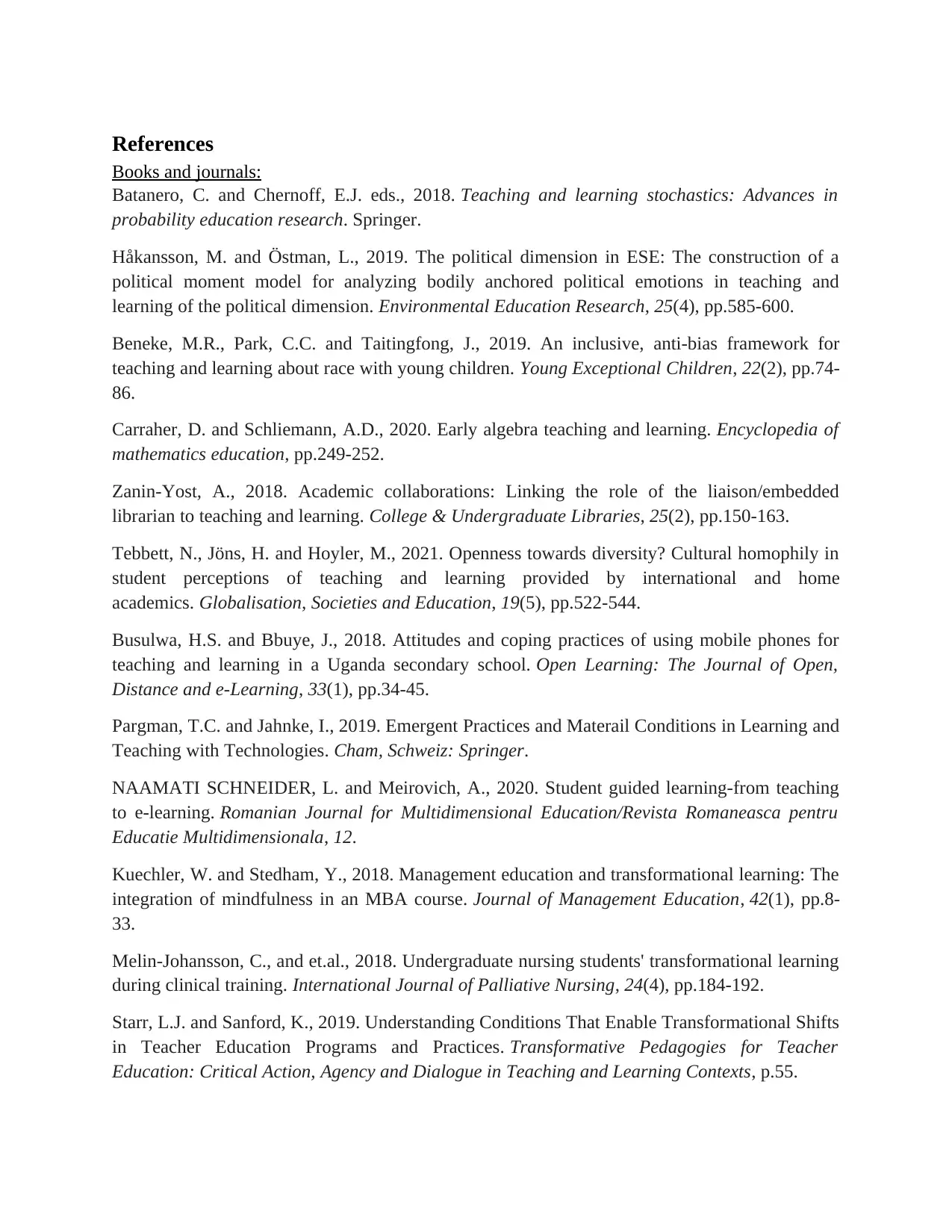
References
Books and journals:
Batanero, C. and Chernoff, E.J. eds., 2018. Teaching and learning stochastics: Advances in
probability education research. Springer.
Håkansson, M. and Östman, L., 2019. The political dimension in ESE: The construction of a
political moment model for analyzing bodily anchored political emotions in teaching and
learning of the political dimension. Environmental Education Research, 25(4), pp.585-600.
Beneke, M.R., Park, C.C. and Taitingfong, J., 2019. An inclusive, anti-bias framework for
teaching and learning about race with young children. Young Exceptional Children, 22(2), pp.74-
86.
Carraher, D. and Schliemann, A.D., 2020. Early algebra teaching and learning. Encyclopedia of
mathematics education, pp.249-252.
Zanin-Yost, A., 2018. Academic collaborations: Linking the role of the liaison/embedded
librarian to teaching and learning. College & Undergraduate Libraries, 25(2), pp.150-163.
Tebbett, N., Jöns, H. and Hoyler, M., 2021. Openness towards diversity? Cultural homophily in
student perceptions of teaching and learning provided by international and home
academics. Globalisation, Societies and Education, 19(5), pp.522-544.
Busulwa, H.S. and Bbuye, J., 2018. Attitudes and coping practices of using mobile phones for
teaching and learning in a Uganda secondary school. Open Learning: The Journal of Open,
Distance and e-Learning, 33(1), pp.34-45.
Pargman, T.C. and Jahnke, I., 2019. Emergent Practices and Materail Conditions in Learning and
Teaching with Technologies. Cham, Schweiz: Springer.
NAAMATI SCHNEIDER, L. and Meirovich, A., 2020. Student guided learning-from teaching
to e-learning. Romanian Journal for Multidimensional Education/Revista Romaneasca pentru
Educatie Multidimensionala, 12.
Kuechler, W. and Stedham, Y., 2018. Management education and transformational learning: The
integration of mindfulness in an MBA course. Journal of Management Education, 42(1), pp.8-
33.
Melin-Johansson, C., and et.al., 2018. Undergraduate nursing students' transformational learning
during clinical training. International Journal of Palliative Nursing, 24(4), pp.184-192.
Starr, L.J. and Sanford, K., 2019. Understanding Conditions That Enable Transformational Shifts
in Teacher Education Programs and Practices. Transformative Pedagogies for Teacher
Education: Critical Action, Agency and Dialogue in Teaching and Learning Contexts, p.55.
Books and journals:
Batanero, C. and Chernoff, E.J. eds., 2018. Teaching and learning stochastics: Advances in
probability education research. Springer.
Håkansson, M. and Östman, L., 2019. The political dimension in ESE: The construction of a
political moment model for analyzing bodily anchored political emotions in teaching and
learning of the political dimension. Environmental Education Research, 25(4), pp.585-600.
Beneke, M.R., Park, C.C. and Taitingfong, J., 2019. An inclusive, anti-bias framework for
teaching and learning about race with young children. Young Exceptional Children, 22(2), pp.74-
86.
Carraher, D. and Schliemann, A.D., 2020. Early algebra teaching and learning. Encyclopedia of
mathematics education, pp.249-252.
Zanin-Yost, A., 2018. Academic collaborations: Linking the role of the liaison/embedded
librarian to teaching and learning. College & Undergraduate Libraries, 25(2), pp.150-163.
Tebbett, N., Jöns, H. and Hoyler, M., 2021. Openness towards diversity? Cultural homophily in
student perceptions of teaching and learning provided by international and home
academics. Globalisation, Societies and Education, 19(5), pp.522-544.
Busulwa, H.S. and Bbuye, J., 2018. Attitudes and coping practices of using mobile phones for
teaching and learning in a Uganda secondary school. Open Learning: The Journal of Open,
Distance and e-Learning, 33(1), pp.34-45.
Pargman, T.C. and Jahnke, I., 2019. Emergent Practices and Materail Conditions in Learning and
Teaching with Technologies. Cham, Schweiz: Springer.
NAAMATI SCHNEIDER, L. and Meirovich, A., 2020. Student guided learning-from teaching
to e-learning. Romanian Journal for Multidimensional Education/Revista Romaneasca pentru
Educatie Multidimensionala, 12.
Kuechler, W. and Stedham, Y., 2018. Management education and transformational learning: The
integration of mindfulness in an MBA course. Journal of Management Education, 42(1), pp.8-
33.
Melin-Johansson, C., and et.al., 2018. Undergraduate nursing students' transformational learning
during clinical training. International Journal of Palliative Nursing, 24(4), pp.184-192.
Starr, L.J. and Sanford, K., 2019. Understanding Conditions That Enable Transformational Shifts
in Teacher Education Programs and Practices. Transformative Pedagogies for Teacher
Education: Critical Action, Agency and Dialogue in Teaching and Learning Contexts, p.55.
Paraphrase This Document
Need a fresh take? Get an instant paraphrase of this document with our AI Paraphraser
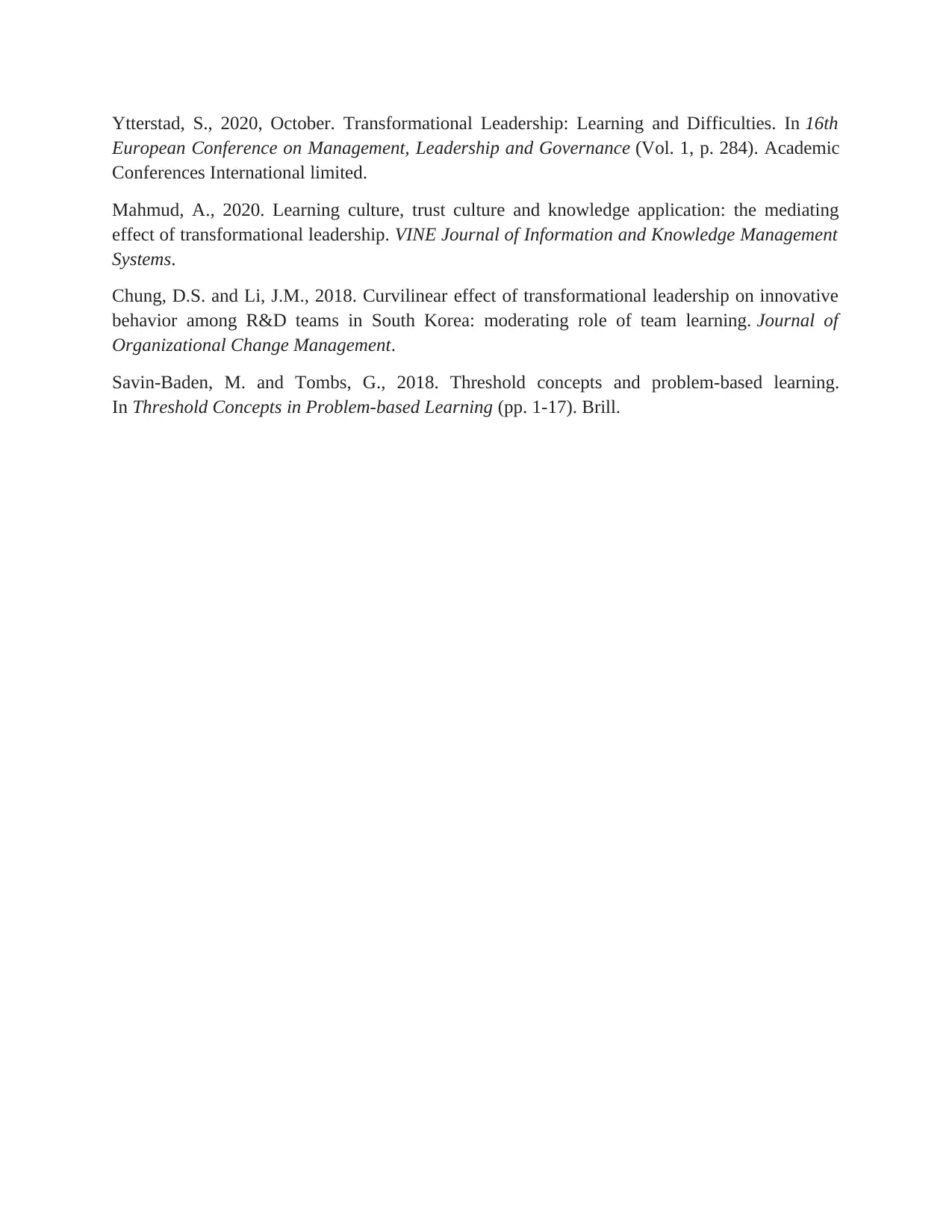
Ytterstad, S., 2020, October. Transformational Leadership: Learning and Difficulties. In 16th
European Conference on Management, Leadership and Governance (Vol. 1, p. 284). Academic
Conferences International limited.
Mahmud, A., 2020. Learning culture, trust culture and knowledge application: the mediating
effect of transformational leadership. VINE Journal of Information and Knowledge Management
Systems.
Chung, D.S. and Li, J.M., 2018. Curvilinear effect of transformational leadership on innovative
behavior among R&D teams in South Korea: moderating role of team learning. Journal of
Organizational Change Management.
Savin-Baden, M. and Tombs, G., 2018. Threshold concepts and problem-based learning.
In Threshold Concepts in Problem-based Learning (pp. 1-17). Brill.
European Conference on Management, Leadership and Governance (Vol. 1, p. 284). Academic
Conferences International limited.
Mahmud, A., 2020. Learning culture, trust culture and knowledge application: the mediating
effect of transformational leadership. VINE Journal of Information and Knowledge Management
Systems.
Chung, D.S. and Li, J.M., 2018. Curvilinear effect of transformational leadership on innovative
behavior among R&D teams in South Korea: moderating role of team learning. Journal of
Organizational Change Management.
Savin-Baden, M. and Tombs, G., 2018. Threshold concepts and problem-based learning.
In Threshold Concepts in Problem-based Learning (pp. 1-17). Brill.
1 out of 11
Related Documents
Your All-in-One AI-Powered Toolkit for Academic Success.
+13062052269
info@desklib.com
Available 24*7 on WhatsApp / Email
![[object Object]](/_next/static/media/star-bottom.7253800d.svg)
Unlock your academic potential
Copyright © 2020–2025 A2Z Services. All Rights Reserved. Developed and managed by ZUCOL.




